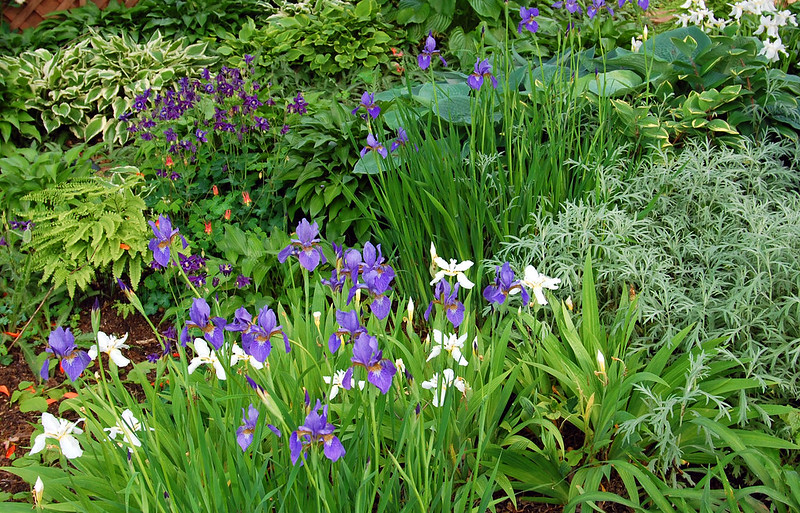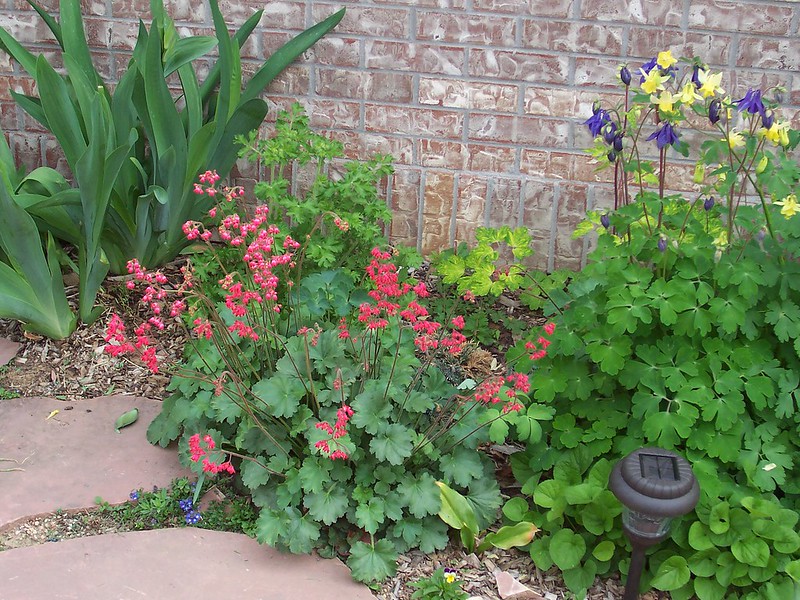While columbine is known for its flowers, this herbaceous perennial has much to offer a landscape. Dark green foliage emerges in the spring, followed by charming and distinctive bell-shaped flowers. The foliage stays in place after the flowers fade and turns a deep maroon hue in the fall. Columbine prefers full sun and cool temperatures, so choose a location that receives morning sun and afternoon shade, especially in warm climates. Otherwise, this perennial is adaptable and works well in a mixed bed or border.

Photo by Mark Levisay, unedited, Flickr, Copyright CC BY 2.0
Shrubs To Plant With Columbine
You have a lot of options when it comes to selecting shrubs to pair with columbine. Choose a shrub that enjoys full sun or partial shade, and evenly moist soil like an azalea or rhododendron. If you live in a warm climate, select a large shrub, like camellia, and plant that to the south of the columbine so the camellia will cast shade on the columbine during the afternoon.
Perennials To Plant With Columbine
Create a dazzling and colorful springtime display by planting multiple columbine plants in a bed. Select plants with the same color flowers for a monochromatic look, or choose different flower hues for a vibrant look. Artemisia is a foliage plant with delicate-looking, feathery leaves, often with a silver hue. This plant stays compact thanks to its mounding growth habit and often reaches 6 to 12 inches tall, so plant artemisia in front of columbine for a tiered look.
Much like columbine, Solomon's seal is a three-season herbaceous perennial. Springtime flowers lead to colorful berries, and the leaves turn a deep, golden-yellow color during the fall that will complement the colorful fall foliage of the columbine. Solomon's seal requires partial sun, so it aligns with the sunlight requirements for columbine.
Siberian iris not only has the same culture requirements as columbine, but also has the perfect contrasting shape. This iris is cold hardy and prefers full to partial sunlight. It blooms about the same time as columbine, making them good companions. The strap-like foliage stays in place after the flowers fade, providing continued interest.

Photo by Patrick Standish, unedited, Flickr, Copyright CC BY 2.0
Annuals To Plant With Columbine
Several annuals pair nicely with columbine, including violas, impatiens, and petunias. These easy bloomers enjoy cool weather like columbine and bloom in early spring, matching up with columbine’s bloom period. They also prefer consistently moist, rich soil, and like columbine, will readily self-seed in the right conditions. Plant the annuals in front of columbine and choose blooms in cool colors for a coordinated, layered look.
Best Companion Plants For Columbine in Containers
Partial shade plants, like hostas, ferns, and coral bells, all work well in a container with columbine. Use these shade perennials as fillers when featured in a container. Columbine is often taller, so position each plant in the container to ensure it is visible. The advantage of this container combination is that all plants are hardy perennials, so the planter will not need to be stored or replanted each year.
Plants Not To Grow With Columbine
Columbine struggles in hot temperatures, so plants that prefer heat and full sun, like salvia and crape myrtle, are not a good match. Established columbine plants are somewhat drought tolerant, but they thrive in damp conditions, and it’s helpful if you water them during a dry spell. Plants that thrive in dry conditions, like sedum, lavender, and rosemary, will not grow well alongside columbine because columbine prefers more moisture than these plants can handle.
Best Plants To Grow With Columbine
Columbine plants have an old-fashioned or classic garden look and offer multiple seasons of color and foliage interest. Feature these flowering perennials with woodland foliage plants like hostas, ferns, and coral bells for long-lasting interest and textural contrast. Include rhododendrons and camellias for a flowering evergreen backdrop.
 |
Author Alison Cotsonas - Published 09-27-2023 |




